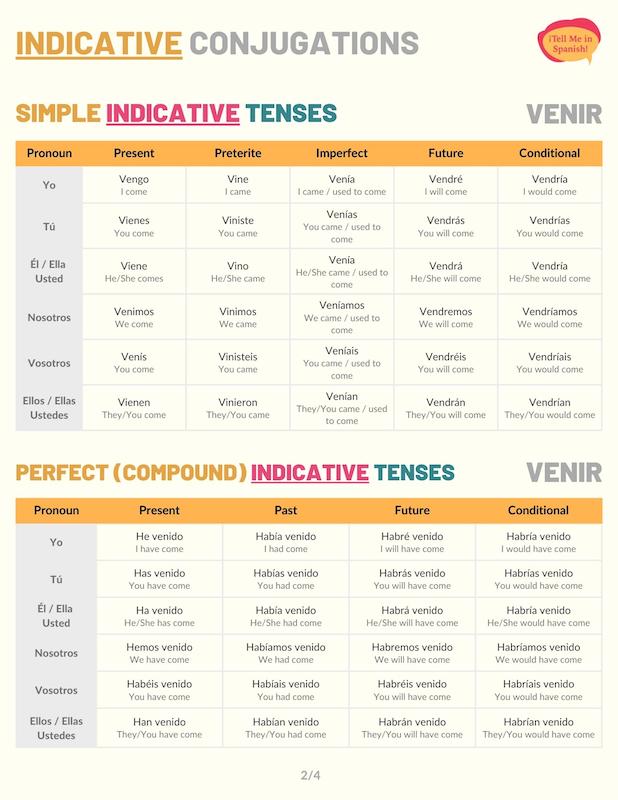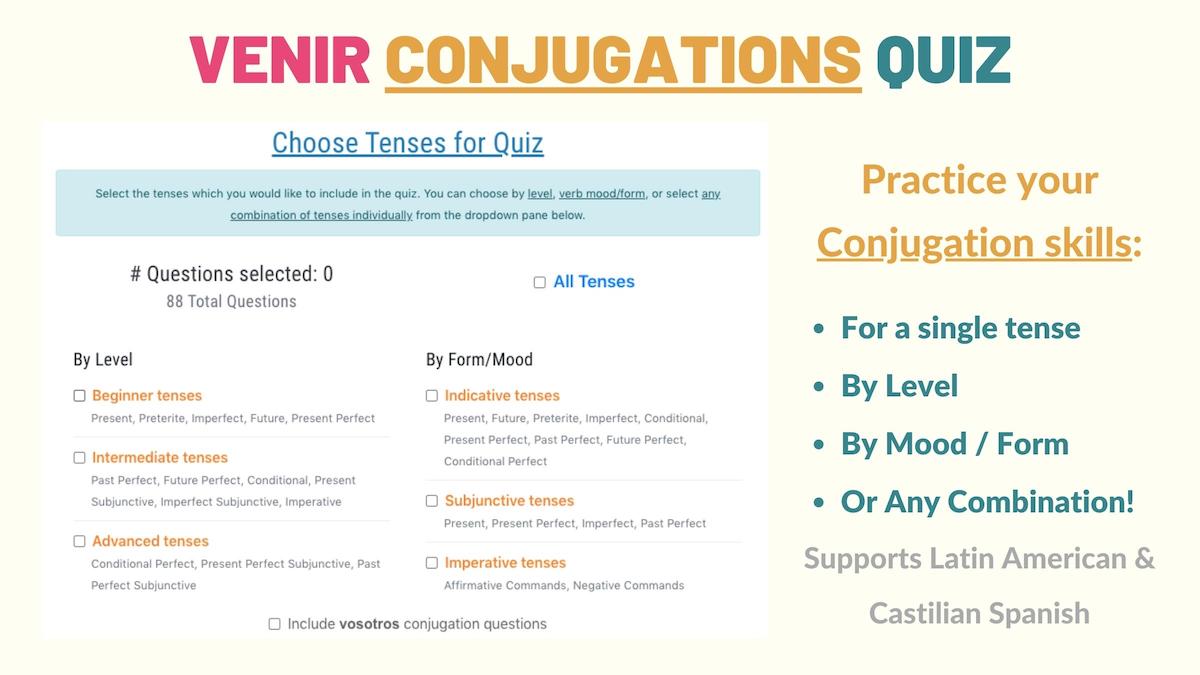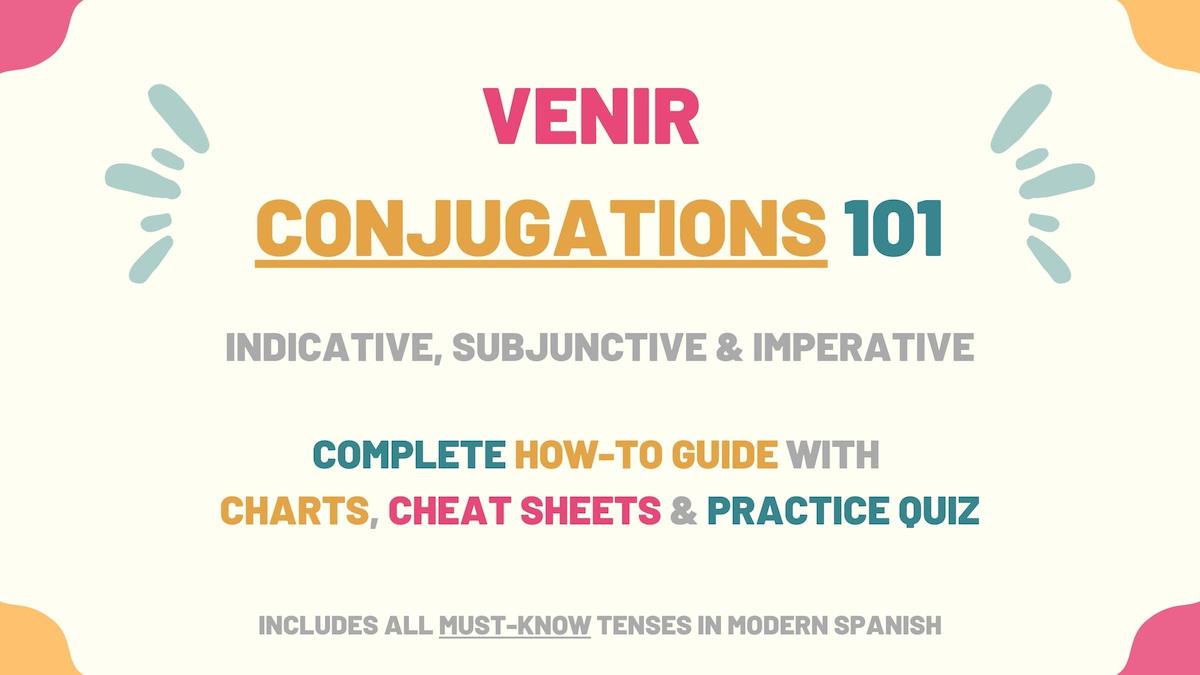Venir is an irregular verb in Spanish. However, on top of its irregularities, this verb also has E to I and E to IE stem changes in certain tenses. Since it can be challenging to conjugate, we’ll go over the venir conjugation charts in this guide.
- Venir Overview
- Indicative Tenses of Venir Conjugations
- Subjunctive Tenses of Venir Conjugations
- Imperative (Commands) of Venir Conjugations
- Uses & Examples
- Download Venir Conjugation Tables & Uses Cheat sheets
- Venir Conjugation Practice Quiz
Overview of Venir
| Verb Characteristic | Property |
|---|---|
| Verb Type | -IR |
| Irregular | Yes |
| Infinitive | Venir |
| Gerund (Present Participle) Form | Viniendo |
| Past Participle Form | Venido |
| Synonyms | Volver, regresar, originarse. |
Irregularities:
- Present: veng only for ‘yo’.
- Future & Conditional: vendr for all subject pronouns.
- Present Subjunctive: veng for all subject pronouns.
- Affirmative Imperative: ven only for ‘tú’, veng for ‘usted’ and ‘ustedes’.
- Negative Imperative: veng for all subject pronouns.
Stem Changes: E to I and E to IE
- Present: vien for all subject pronouns except ‘nosotros’ and ‘vosotros’.
- Preterite: vin for all subject pronouns and omit accent marks.
- Imperfect Subjunctive: vinie for all subject pronouns.
In Spanish, the verb venir means ‘to come’, ‘to arrive’, ‘to appear’, among other applications. The conjugation charts below only have one translation to keep the tables as organized as possible. You can check more uses of this verb in the section Uses & Meanings.
Indicative Conjugations of Venir
Present tense
Venir present conjugation is irregular for the form ‘yo’, in which case, you must use the stem veng. Except for ‘nosotros’ and ‘vosotros’, the remaining subject pronouns have an E to IE stem change. You can see these patterns in the venir conjugation chart below.
Use these venir conjugations to express that someone comes to a certain place in the present moment. For instance: ¿De dónde vienes?
| Person | Conjugation | Translation |
|---|---|---|
| Yo | Vengo | I come |
| Tú | Vienes | You come |
| Él / Ella Usted | Viene | He/She comes You (formal) come |
| Nosotros | Venimos | We come |
| Vosotros | Venís | You come |
| Ellos / Ellas Ustedes | Vienen | They come You (plural) come |
Preterite tense
The preterite conjugations of venir have an E to I stem change for all subject pronouns. Use venir preterite conjugations to mention that someone came to a place. For example: Mis abuelos vinieron a visitarnos el lunes.
| Person | Conjugation | Translation |
|---|---|---|
| Yo | Vine | I came |
| Tú | Viniste | You came |
| Él / Ella Usted | Vino | He/She came You (formal) came |
| Nosotros | Vinimos | We came |
| Vosotros | Vinisteis | You came |
| Ellos / Ellas Ustedes | Vinieron | They came You (plural) came |
Imperfect tense
Venir is a regular verb with no stem changes in the Spanish imperfect tense. With this tense, this verb is used to communicate that someone used to come to a place for an extended period of time. For example: Cuando éramos niños, nosotros siempre veníamos a tu casa.
| Person | Conjugation | Translation |
|---|---|---|
| Yo | Venía | I came I used to come |
| Tú | Venías | You came You used to come |
| Él / Ella Usted | Venía | He/She came He/She used to come You (formal) came You (formal) used to come |
| Nosotros | Veníamos | We came We used to come |
| Vosotros | Veníais | You came You used to come |
| Ellos / Ellas Ustedes | Venían | They came They used to come You (plural) came You (plural) used to come |
Near future
The immediate or near future in Spanish is formed with ir (present tense) + a + infinitive verb (venir, in this case). These conjugations convey that a person will come to a place soon in the future. ¿Cuándo vas a venir a México?
| Person | Conjugation | Translation |
|---|---|---|
| Yo | Voy a venir | I’m going to come |
| Tú | Vas a venir | You’re going to come |
| Él / Ella Usted | Va a venir | He/She is going to come You (formal) are going to come |
| Nosotros | Vamos a venir | We’re going to come |
| Vosotros | Vais a venir | You’re going to come |
| Ellos / Ellas Ustedes | Van a venir | They’re going to come You (plural) are going to come |
Future simple tense
In Spanish, venir’s future conjugations are irregular. To form the future simple tense, you must use the stem vendr. With these conjugations, you can say that someone will come to a place at some moment in the future. Vendremos por ti a las 8.
| Person | Conjugation | Translation |
|---|---|---|
| Yo | Vendré | I will come |
| Tú | Vendrás | You will come |
| Él / Ella Usted | Vendrá | He/She will come You (formal) will come |
| Nosotros | Vendremos | We will come |
| Vosotros | Vendréis | You (formal) will come |
| Ellos / Ellas Ustedes | Vendrán | They will come You (plural) will come |
Take Note: Venir is one of the few irregular verbs in the future tense in Spanish.
Conditional tense
To form the conditional tense of venir, add the conditional endings to the irregular stem vendr. You can see these patterns in the conjugation chart below. These forms allow you to express that someone would come to a place if a condition is met. ¿A qué vendrían tus primos?
| Person | Conjugation | Translation |
|---|---|---|
| Yo | Vendría | I would come |
| Tú | Vendrías | You would come |
| Él / Ella Usted | Vendría | He/She would come You (formal) would come |
| Nosotros | Vendríamos | We would come |
| Vosotros | Vendríais | You would come |
| Ellos / Ellas Ustedes | Vendrían | They would come You (plural) would come |
Present perfect tense
To form the Spanish present perfect, use the formula haber (present tense) + venido (past participle). When conjugated to this tense, venir expresses that someone has or hasn’t come to a place. For instance: ¿No ha venido el plomero?
| Person | Conjugation | Translation |
|---|---|---|
| Yo | He venido | I have come |
| Tú | Has venido | You have come |
| Él / Ella Usted | Ha venido | He/She has come You (formal) have come |
| Nosotros | Hemos venido | We have come |
| Vosotros | Habéis venido | You have come |
| Ellos / Ellas Ustedes | Han venido | They have come You (plural) have come |
Past perfect
Haber (imperfect tense) + past participle of ‘venir’ is how you form the past perfect tense in Spanish. Conjugate venir to this tense to convey that someone had or hadn’t come to a place before another past action or point in time.
For instance: No habíamos venido porque teníamos mucho trabajo.
| Person | Conjugation | Translation |
|---|---|---|
| Yo | Había venido | I had come |
| Tú | Habías venido | You had come |
| Él / Ella Usted | Había venido | He/She had come You (formal) had come |
| Nosotros | Habíamos venido | We had come |
| Vosotros | Habíais venido | You had come |
| Ellos / Ellas Ustedes | Habían venido | They had come You (plural) had come |
Future perfect
Use venir conjugated to the future perfect tense in Spanish to say that people will have come to a place by or before a specific moment in the future. With these conjugations, you can also express that someone might have come to a location.
For example: ¿Por qué no habrán venido mis amigos?
| Person | Conjugation | Translation |
|---|---|---|
| Yo | Habré venido | I will have come |
| Tú | Habrás venido | You will have come |
| Él / Ella Usted | Habrá venido | He/She will have come You (formal) will have come |
| Nosotros | Habremos venido | We will have come |
| Vosotros | Habréis venido | You will have come |
| Ellos / Ellas Ustedes | Habrán venido | They will have come You (plural) will have come |
Conditional perfect
In the conditional perfect tense, venir communicates that someone would have come if a past condition had been fulfilled. For instance: Si Gabriel te hubiera invitado, sí habrías venido.
| Person | Conjugation | Translation |
|---|---|---|
| Yo | Habría venido | I would have come |
| Tú | Habrías venido | You would have come |
| Él / Ella Usted | Habría venido | He/She would have come You (formal) would have come |
| Nosotros | Habríamos venido | We would have come |
| Vosotros | Habríais venido | You would have come |
| Ellos / Ellas Ustedes | Habrían venido | They would have come You (plural) would have come |
Progressive tenses
The progressive forms of venir emphasize that someone is coming to a place at the moment of speaking. Or, in the case of past tenses (preterite or imperfect), they explain that a past action occurred when someone was coming to a location. For example: Estarán viniendo muchos expertos.
| Progressive Tense | Formula | Translation Example |
|---|---|---|
| Present | Estar (present) + viniendo | I am coming |
| Preterite | Estar (preterite) + viniendo | You were coming |
| Imperfect | Estar (imperfect) + viniendo | He was coming |
| Future | Estar (future) + viniendo | We will be coming |
| Conditional | Estar (conditional) + viniendo | They would be coming |
Take Note: With these tenses, it’s more common to use the verb ir to explain that you’re in the process of going somewhere.
Venir Subjunctive Conjugations
The Spanish subjunctive allows you to express hopes, demands, advice, wishes, expectations, or hypothetical situations. In the sections below, you’ll learn how to conjugate venir to the most common subjunctive tenses you need to become fluent in modern Spanish.
Present subjunctive
Venir subjunctive conjugations are formed with the irregular stem veng. Use the present subjunctive conjugations of this verb to suggest, request, or hope that someone will come to the location you’re at. For instance: No quiero que tus amigos vengan a mi fiesta.
| Person | Conjugation | Translation |
|---|---|---|
| Yo | Venga | I come |
| Tú | Vengas | You come |
| Él / Ella Usted | Venga | He/She comes You (formal) come |
| Nosotros | Vengamos | We come |
| Vosotros | Vengáis | You come |
| Ellos / Ellas Ustedes | Vengan | They come You (plural) come |
Present perfect subjunctive
In Spanish, the present perfect subjunctive forms of ‘venir’ are formed with haber (present subjunctive) + venido. Use these conjugations to wish or wonder if a person has already come to the location someone is. For example: Ojalá haya venido mi mejor amiga.
| Person | Conjugation | Translation |
|---|---|---|
| Yo | Haya venido | I have come |
| Tú | Hayas venido | You have come |
| Él / Ella Usted | Haya venido | He/She has come You (formal) have come |
| Nosotros | Hayamos venido | We have come |
| Vosotros | Hayáis venido | You have come |
| Ellos / Ellas Ustedes | Hayan venido | They have come You (plural) have come |
Imperfect subjunctive
To conjugate this verb to the imperfect subjunctive tense, use the stem vin for all subject pronouns. These venir conjugations allow you to express past expectations, hypotheses, requests, or wishes about a person coming to your location.
Here is an example: Quería que ustedes vinieran a mi fiesta.
In Spanish, there are two conjugation models to form the imperfect subjunctive tense:
Latin American Spanish version
| Person | Conjugation | Translation |
|---|---|---|
| Yo | Viniera | I came |
| Tú | Vinieras | You came |
| Él / Ella Usted | Viniera | He/She came You (formal) came |
| Nosotros | Viniéramos | We came |
| Ellos / Ellas Ustedes | Vinieran | They came You (plural) came |
Note: Vosotros is never used in Latin American Spanish-speaking countries. As a result, the venir conjugation for this pronoun hasn’t been included in the table above.
Castilian Spanish version
| Person | Conjugation | Translation |
|---|---|---|
| Yo | Viniese | I came |
| Tú | Vinieses | You came |
| Él / Ella Usted | Viniese | He/She came You (formal) came |
| Nosotros | Viniésemos | We came |
| Vosotros | Vinieseis | You came |
| Ellos / Ellas Ustedes | Viniesen | They came You (plural) came |
Past perfect subjunctive
In the Spanish past perfect subjunctive, this verb expresses that someone would have come to your location if a past condition had taken place. You can also use these forms to express regret related to a person coming to the place you’re at.
For example: Hubiéramos venido si nos hubieras dicho que era importante.
| Person | Conjugation | Translation |
|---|---|---|
| Yo | Hubiera venido | I had come |
| Tú | Hubieras venido | You had come |
| Él / Ella Usted | Hubiera venido | He/She had come You (formal) had come |
| Nosotros | Hubiéramos venido | We had come |
| Vosotros | Hubierais venido | You had come |
| Ellos / Ellas Ustedes | Hubieran venido | They had come You (plural) had come |
Venir Imperative Conjugations
Conjugate a verb to its imperative form to give commands in Spanish. Use affirmative commands to order someone to do something or negative commands to instruct someone not to do something.
Affirmative commands
Venir affirmative commands conjugations are only regular for the pronoun ‘vosotros’. Use veng for ‘usted’ and ‘ustedes’, and ven for ‘tú’. You can use these commands to order people to come to your location. Vengan, les quiero enseñar algo.
| Person | Conjugation | Translation |
|---|---|---|
| Tú | Ven | Come |
| Usted | Venga | Come |
| Vosotros | Venid | Come |
| Ustedes | Vengan | Come |
Negative commands
This verb’s negative imperative conjugations are formed with the irregular stem veng. These conjugations allow you to order people not to come to a place. For instance: No vengas, ya nos fuimos.
| Person | Conjugation | Translation |
|---|---|---|
| Tú | No vengas | Don’t come |
| Usted | No venga | Don’t come |
| Vosotros | No vengáis | Don’t come |
| Ustedes | No vengan | Don’t come |
Meanings of Venir & Examples
Since we’ve already seen how to conjugate venir in Spanish, in this section, you’ll learn this verb’s most common applications.
- Expressing that someone is coming to a place
[Venir conjugated] + [complement]
Tu tía va a venir a la casa.
Your aunt is coming to the house.
La bebé viene dormida.
The baby is asleep.
El plomero vendrá a arreglar el lavabo.
The plumber will come to fix the sink.
Take Note: Venir expresses that someone is coming to the speaker’s location. Combine this verb with an infinitive verb to express that someone is coming over to do something (example #3). Use past participles working as adjectives to describe how someone is coming to a place.
- Saying something’s origin or that appears somewhere
[Venir conjugated] + (en) + (noun)
La noticia viene en la página 40.
The news is on page 40.
La palabra ‘almohada’ viene del árabe.
The word ‘almohada’ comes from Arabic.
Take Note: Venir can be combined with present participles to express an ongoing action. However, in this context, it’s more common to use the verb estar or llevar.
Download Venir Conjugation Charts & Uses Cheat sheets

Venir is an irregular -IR verb with many stem changes, so it can take time for beginners to learn by heart. I’ve created a PDF you can download containing all the venir conjugation tables. You’ll also find its meanings along with real-world examples of this verb in use.
Practice Quiz: Venir Conjugation

You’ve now know how to conjugate the verb venir. The next step is to take the venir conjugation practice quiz to drill yourself on all its regular and irregular forms.





